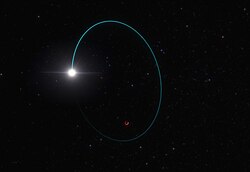Gaia BH3
| Observation data Epoch J2016.0 Equinox J2016.0 | |
|---|---|
| Constellation | Aquila |
| Right ascension | 19h 39m 18.72s[1] |
| Declination | +14° 55′ 54.2″[1] |
| Characteristics | |
| Star | |
| Evolutionary stage | Giant star |
| Spectral type | G |
| Black hole | |
| Evolutionary stage | Stellar black hole |
| Astrometry | |
| Radial velocity (Rv) | -333.2 ±3.4[2] km/s |
| Proper motion (μ) | RA: -28.317 ±0.067 mas/yr[2] Dec.: -155.221 ±0.111 mas/yr[2] |
| Parallax (π) | 1.6933 ± 0.0164 mas[2] |
| Distance | 1,930 ± 20 ly (591 ± 6 pc) |
| Orbit[2] | |
| Period (P) | 4,253.1±98.5 d |
| Semi-major axis (a) | 16.17 ± 0.27 AU |
| Eccentricity (e) | 0.7291 ±0.0048 |
| Inclination (i) | 110.580 ±0.095° |
| Longitude of the node (Ω) | 136.236 ±0.128° |
| Periastron epoch (T) | JD, TCB 2458177.39 ± 0.88 |
| Argument of periastron (ω) (secondary) | 77.34 ±0.76° |
| Details[2] | |
| Star | |
| Mass | 0.76±0.05 M☉ |
| Radius | 4.936 ± 0.016 R☉ |
| Surface gravity (log g) | 2.929 ±0.003 cgs |
| Temperature | 5212 ±80 K |
| Metallicity [Fe/H] | -2.56 ± 0.11 dex |
| Black hole | |
| Mass | 32.70±0.82 M☉ |
| Other designations | |
| Database references | |
| SIMBAD | data |
Gaia BH3 (Gaia DR3 4318465066420528000) is a binary system consisting of a metal-poor giant star with spectral type G and a stellar-mass black hole. Gaia BH3 is located 1926 light years away (590.6±5.8 pc away) in the constellation of Aquila, making it as of 2024[update] the heaviest known black hole system second-closest to Earth. Gaia BH3 is the first black hole discovered from preliminary Gaia DR4 astrometric data.[2]
The black hole and star orbit the system barycentre every 11.6 years, with an orbital distance ranging from 4.5–29 AU.[3] The black hole's mass is 32.70 M☉, the heaviest known stellar black hole in the Milky Way.
The black hole Gaia BH3 is together with Cygnus X-1 the only known stellar black hole more massive than about 10 M☉. The mass of Gaia BH3 is quite similar to the mass of merging binary black holes found via gravitational waves. These massive black holes were suspected to be formed by metal-poor stars and the fact that Gaia BH3 has a metal-poor companion strengthens this conclusion.[2]
Gaia BH3 was found to be part of a disrupted star cluster of low mass and this star cluster is today a halo stellar stream, called ED-2. This stellar stream is very old, with an age comparable to the globular cluster Messier 92. This means that Gaia BH3 likely formed more than 13 billion years ago and the black hole might have formed via direct collapse of a massive star. Alternatively the black hole could have formed via binary interaction inside the star cluster. ED-2 has a mass between 2,000 M☉ and 42,000 M☉.[4]
Discovery[edit]
Gaia BH3 was identified in astrometric observations with Gaia, during an analysis in preparation for Data Release 4. It was announced with the publication of a scientific paper in the journal Astronomy & Astrophysics on 16 April 2024.[2][5]
References[edit]
- ^ a b Vallenari, A.; et al. (Gaia collaboration) (2023). "Gaia Data Release 3. Summary of the content and survey properties". Astronomy and Astrophysics. 674: A1. arXiv:2208.00211. Bibcode:2023A&A...674A...1G. doi:10.1051/0004-6361/202243940. S2CID 244398875. Gaia DR3 record for this source at VizieR.
- ^ a b c d e f g h Panuzzo, P.; Panuzzo (2024). "Discovery of a dormant 33 solar-mass black hole in pre-release Gaia astrometry". The Astrophysical Journal. arXiv:2404.10486. Bibcode:2024arXiv240410486G. doi:10.1051/0004-6361/202449763.
- ^ Dunham, Will (April 16, 2024). "Astronomers detect Milky Way's second-largest known black hole". Reuters.
- ^ Balbinot, E.; Dodd, E.; Matsuno, T.; Lardo, C.; Helmi, A.; Panuzzo, P.; Mazeh, T.; Holl, B.; Caffau, E.; Jorissen, A.; Babusiaux, C.; Gavras, P.; Wyrzykowski, L.; Eyer, L.; Leclerc, N.; Bombrun, A.; Mowlavi, N.; Seabroke, G. M.; Teyssier, D.; Cabrera-Ziri, I.; Callingham, T. M.; Ruiz-Lara, T.; Starkenburg, E. (April 2024). "The 33 M⊙ black hole Gaia BH3 is part of the disrupted ED-2 star cluster". arXiv:2404.11604 [astro-ph.GA].
- ^ "Most massive stellar black hole in our galaxy found". European Southern Observatory. 16 April 2024. Archived from the original on 16 April 2024.

